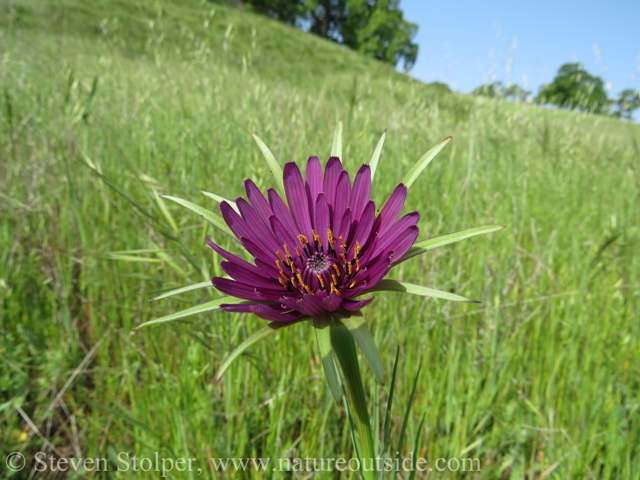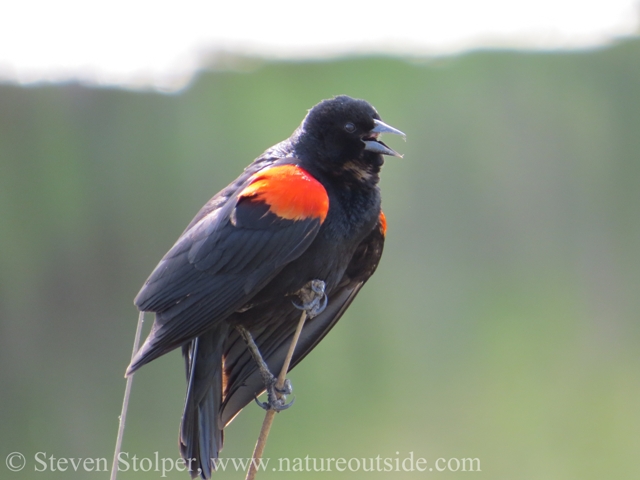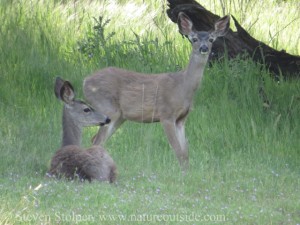
Salsify (Tragopogon porrifolius). Not native to California.
Happy Equinox!
March 20 was the Vernal Equinox. You may have missed it if you weren’t paying attention. After all, it’s not like we get off from work!
The Vernal equinox marks the beginning of spring. It occurs around March 20 in the northern hemisphere and around September 22 in the southern hemisphere. For those of us living in the United States, it’s the moment when the northern hemisphere begins to tilt toward the sun. If you recall, summer is when your hemisphere tilts toward the sun, receiving its warming rays directly. Winter is the opposite. The sun sits low on the horizon and the days are cold and short. On an equinox, day and night are of approximately equal length all over the planet.
So our northern hemisphere changed direction, like our sun yanked on its giant leash. But most of us don’t notice astronomical events. We see the world around us.
Get into Your Time Machine

Red-winged Blackbird (Agelaius phoeniceus) issuing a territorial call
As I mentioned before, bushcrafters have a time machine. Our connection to nature keeps us attuned to the passage of time. We notice flowers blooming, birds singing, and fawns trailing behind their mothers. We see butterflies appear as if by magic. Frogs croak at night and day-glo pine needles spring from branches of douglas firs.
Today, most people have lost touch with time. I don’t mean we can’t read a wristwatch. I mean we have lost our connection to the physical passage of time in our universe. We look down at our mobile devices more than we look at the world around us.
But even as bushcrafters we are out of step with our environment in some fundamental ways.
Answer these two questions:
- How many years have you been alive?
- How many times have you seen the sun rise?
Night and day are optional now. We’re completely disconnected from the physical cycles of our world. We stay up as late as we want and we rise whenever the alarm clock wakes us. As a result many of us walk around perpetually sleep-deprived.

Black-tailed deer in Northern California. Black-tailed deer are a subspecies of mule deer.
Think how different your life would be if every electric light on the planet disappeared. You would rise with the sun and sleep when it’s dark. The long summer days and the long winter nights would have real meaning. You would mark the passage of time because your life was interwoven with the Earth’s natural cycles.
So use nature to connect yourself to the passage of time. Notice the leaves turning, the snow thawing, the flowers blooming, and the berries ripening. Harvest acorns in autumn, delicious greens in spring, seeds in summer, and berries as the days get shorter. Bushcraft joins us to Earth’s natural cycles – but only if we’re receptive.
What do Scientists See?
The New York Times published an interesting article that I want to share with you. It asked eight scientists what they notice around them as we enter spring. I loved their answers! I share many in common with the scientists by dint of where I live. I see the migrating Gray Whales. I smell petrichor after spring rains. And I hear the birdsong of newly arrived migrants.
Below is a link to the article. Read what the scientists say. Check-out the cool Earth-from-space video to see how seasons affect our planet’s vegetation. How do the scientists’ perspectives differ from ours?
Recognizing Spring, Scientifically
What Do You See?
What changes do you see this time of year? Leave a comment below to let me know.
Related Articles on NatureOutside
Walking in Nature Changes Your Brain!
Wildflowers of the Serpentine Realm
For fun facts and useful tips, join the free Bushcraft Newsletter.



Leave a Comment